Thursday, January 15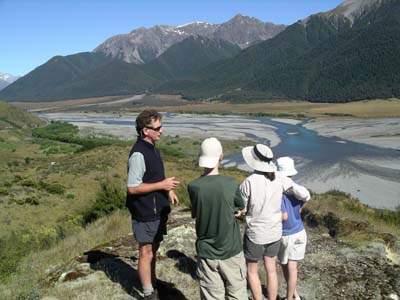
Paula: Today we enjoyed exploring the high country and
Waimakariri Valley east of Arthur's Pass. This area is strikingly different
from the terrain around the lodge where we are staying. The mountains are
of lower elevation and the dry hills are covered in grasses and native plants.
This area, although only 15 minutes from the lodge, gets significantly less
rainfall and a drought this year has made it even more difficult for the sheep
stations in this area. Our guide, John, was previously a teacher and principal
of a large high school on the South Island. He was delightful and knew just
how to help us all learn about this area and have great fun at the same time.
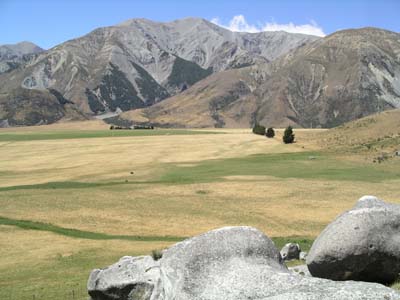
Our first stop was to take a "wee walk" (this is how they describe
anything small or little here) up a gentle hill on Cora Lynn station (another
large sheep farm). The views were especially wonderful today against a brilliant
and cloudless blue sky. Along the hike, John explained how the valley was
carved out by glaciers during multiple ice ages. The braided river below is
like nothing we have ever seen before, with tributaries changing daily. We
saw several kayakers mapping out the tributaries in preparation for an upcoming
race which includes biking, kayaking and running from the west to the east
coast. 
We also examined the inside-out plants which evolved to protect themselves
from the giant Moa birds - John told us these plants are commonly referred
to as "Wild Irishmen." Interestingly, we were introduced to another
prickly plant 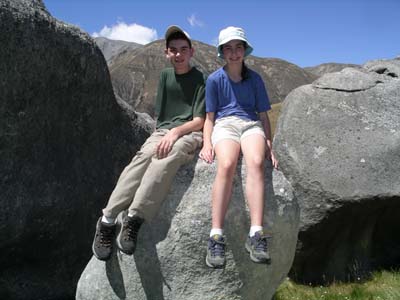 later
in the day called the "Spanish Sword." John explained that many
of the native plants and birds have been endangered by the introduction of
species from other parts of the world. Many of these species were brought
here intentionally but have had unexpected results. For example opossums,
rats and wild boars have impacted the bird population who prior to their introduction
had no mammal predators. Similarly, Douglas Firs were mass planted in the
20th century as part of the timber
later
in the day called the "Spanish Sword." John explained that many
of the native plants and birds have been endangered by the introduction of
species from other parts of the world. Many of these species were brought
here intentionally but have had unexpected results. For example opossums,
rats and wild boars have impacted the bird population who prior to their introduction
had no mammal predators. Similarly, Douglas Firs were mass planted in the
20th century as part of the timber 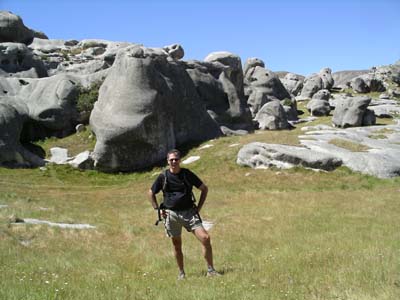 industry
and reforestation efforts but their rapid growth and spread now threatens
native plant life. Later in the day, we enjoyed pulling pine tree's seedlings
as our own personal contribution to preserving New Zealand's ecology!
industry
and reforestation efforts but their rapid growth and spread now threatens
native plant life. Later in the day, we enjoyed pulling pine tree's seedlings
as our own personal contribution to preserving New Zealand's ecology!
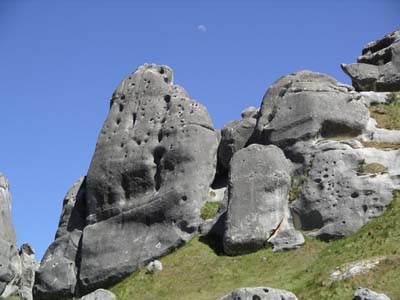 Our
next stop was Castle Hill. This outcrop of limestone rocks is known by the
Maori (the first settlers of New Zealand) as Kura Tawhiti. These massive rocks
littering the hillside at first reminded us of Stonehenge but we quickly learned
they were quite different. These rocks were not molded and arranged by humans
but are a result of the work of nature and evidence that 30 million years
ago New Zealand was covered by
Our
next stop was Castle Hill. This outcrop of limestone rocks is known by the
Maori (the first settlers of New Zealand) as Kura Tawhiti. These massive rocks
littering the hillside at first reminded us of Stonehenge but we quickly learned
they were quite different. These rocks were not molded and arranged by humans
but are a result of the work of nature and evidence that 30 million years
ago New Zealand was covered by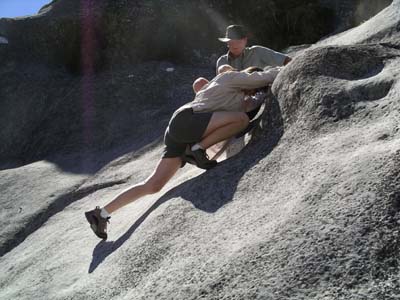 the sea. Millions of fossilized sea life compressed to form sedimentary rock
that was eventually buckled and uplifted by tectonic plates. Then years of
erosion from the wind, rain, sun and lichen have molded them into interesting
shapes.
the sea. Millions of fossilized sea life compressed to form sedimentary rock
that was eventually buckled and uplifted by tectonic plates. Then years of
erosion from the wind, rain, sun and lichen have molded them into interesting
shapes.
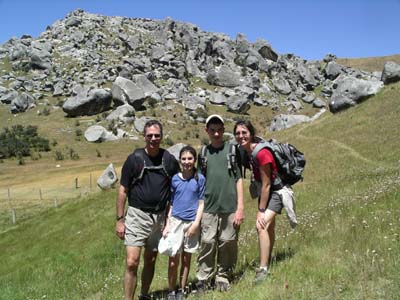 We
had fun walking through the hundreds of stones, finally settling on one to
climb and several to picnic under. John patiently helped us learn some basic
rock climbing techniques and we all had a try (except Steve who instead chose
to photograph us all making fools of ourselves).
We
had fun walking through the hundreds of stones, finally settling on one to
climb and several to picnic under. John patiently helped us learn some basic
rock climbing techniques and we all had a try (except Steve who instead chose
to photograph us all making fools of ourselves).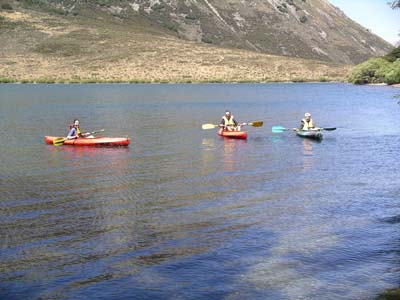
The rocks and area surrounding Castle Hill is magical and it is easy to see
why the Maori tribes found them to have spiritual significance. It is thought
that the Maori farmed, hunted, trained new leaders and even set their calendars
around these rocks.
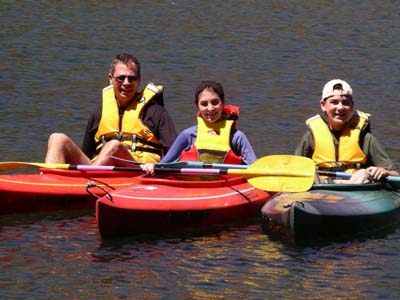 Our
last stop was lovely Lake Pearson. We had time to share this quiet and beautiful
lake in our kayaks with a family of Crested Grebes (endangered, with only
160 left in New Zealand), Scaup and Paradise Ducks. The kayaking was a fun
way to end the day's adventure and it was clear that David and Katie could
have spent the whole day on the lake.
Our
last stop was lovely Lake Pearson. We had time to share this quiet and beautiful
lake in our kayaks with a family of Crested Grebes (endangered, with only
160 left in New Zealand), Scaup and Paradise Ducks. The kayaking was a fun
way to end the day's adventure and it was clear that David and Katie could
have spent the whole day on the lake. 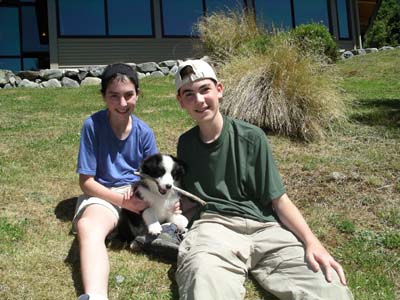
After arriving back at the lodge we found the puppy, Tess, having just finished a nap and ready to play. This was a perfect excuse to put off our journal writing and laundry just a "wee bit" longer.
Distance Walked: 2.26 miles
Katie's Kwik Kwacks: Today we learned a lot about limestone and some
elements of geology by visiting Castle Hill. We learned that if you see limestone
in any place in the world that means it was once under water. This is because
limestone is formed from dead see creatures compressing together over time
to form a very soft stone. We could tell the stone was soft from looking at
the unusual shapes of the stones in Castle Hill. We learned that the shape
of the limestone can be changed by rain, storms, earthquakes, and even strong
wind. We also learned a fair amount on the geological events that make Castle
Hill so unique. We learned that two tectonic plates crash together pushing
the limestone upward and creating the Southern Alps. Beneath the ground at
Castle Hill is more limestone that hasn't been pushed up yet. As you can see,
we had a very interesting experience today and continue to learn more about
the interesting sciences of New Zealand. 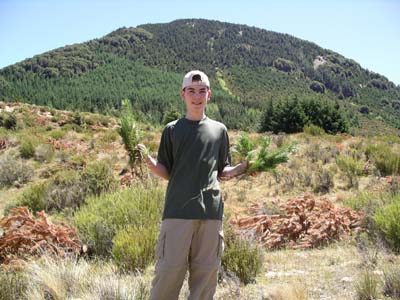
David's Daily Dump: Preserving the environment in New Zealand is one of the main focuses of the country. In fact, the lodge we are staying in is very dedicated to keeping the environment clean, and the owner won the Lode Award in 2003, which is given to the one person that plays the biggest role in helping New Zealand's ecology. There are many conservation efforts in New Zealand, including killing rats and opossums, which eat indigenous bird's eggs. Today on our hike, we contributed in this effort by each pulling out 20 Douglas Firs, which kill native plants. These pine trees grow rapidly and spread like wild-fire. They were introduced to the country in the 30's, and have spread through much of the Alps. The Europeans planted them for lumber harvest, and didn't realize that they were making a huge mistake at the time. Because of their rapid growth, they steal nutrients from the soil, leaving many indigenous plants without food. The efforts to get rid of the tree started about 10 years ago, and volunteers are making progress. The dead trees turn to an orange color, and splotches of orange can be seen in the mountains and valleys. Hopefully these trees will eventually be banished from New Zealand, and the conservation efforts will prove successful in the future.
Katie's Komments: My feelings at the start of our second trip…
The second trip is finally here!!!
It is really exciting to be traveling again, even if it was hard to have to leave home after just getting used to it again. After looking over our long itinerary, it is clear to me that this trip will not be nearly as easy as the first, yet a great deal more exotic. It is good to know that every day is planned out already, and we don't have to worry about any hotel reservations etc. on the road. I think we will all admit that it was a little sad leaving again, especially after spending so much valuable time with family, friends, and pets. However, as soon as we got on the road we quickly got back into the travel routine and started regaining confidence and energy.
I think one of the most thrilling and exciting things about this trip is that we don't really know what to expect. We have no expectations and Mom and Dad have never been to any of the places we're going to either. Another exciting thing about this trip is the great variety of activities we are doing. Most of these things are experiences that will give us a good sense for the culture in these countries and the daily life of their people. Some of these activities include going to schools, visiting villages, and walking through markets. I think these will be some wonderful experiences for us. In addition to these cultural experiences we will be seeing many interesting animals on this trip-lions and tigers and bears-Oh my! Not only in the Serengeti desert in Africa, but also the iguanas and seals in the Galapagos Islands, sea turtles in Australia, and penguins in New Zealand. I think seeing and studying these animals will be so cool!
All in all, I am really excited about this trip and all of the wonderful experiences we will have that will change our views on the world forever.
David's Download: My feelings at the start of our second trip…
Well, the second trip has finally begun. Those two months flew by almost as fast as our 13 hour plane ride to New Zealand (not). It was a hectic two months with the holidays, my high school applications, Katie's painting, Mom and Dad's planning, and settling in back home. Although I was busy, I did manage a couple all-nighters with my friends and some time hanging out in front of the Pats. Leaving again was harder than I had anticipated. It will take a couple of days for me to get used to our traveling routines, but I will eventually get in sync. Don't get me wrong, I am definitely excited about our future travels, but I will miss mint chocolate chip ice cream and mom's homemade cookies with a glass of cold milk (hmmmm).
I am not exactly sure what to expect as we proceed with our journey. Of course I feel adventurous, but getting out there and actually being adventurous is a different story. I guess I'll get more excited as we start doing out of the ordinary activities, such as camel and elephant trekking, but right now I'm not really looking forward to hunting with bows and arrows with one of the last hunter and gatherer tribes in the world. I know may be saying, "That sounds wicked cool." I would too if I knew that I wasn't the one doing it! Anyway, some of the things I am looking forward to are fishing in Australia, taking safaris in the Serengeti, visiting Machu Picchu, and just seeing worlds different from our own.
Well, right now it's Thursday afternoon, which means it's Wednesday evening in Boston. So if anyone wants to know what happens tomorrow, just give us a quick email!
